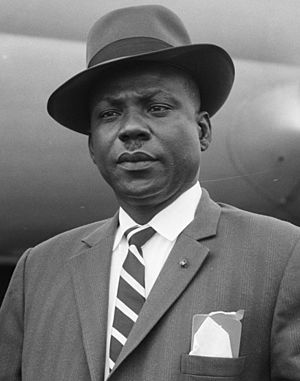Johan Kraag facts for kids
Quick facts for kids
Johan Kraag
|
|
|---|---|
 |
|
| 5th President of Suriname | |
| In office 29 December 1990 – 16 September 1991 |
|
| Vice President | Jules Wijdenbosch |
| Preceded by | Ramsewak Shankar |
| Succeeded by | Ronald Venetiaan |
| 3rd Deputy Prime Minister of Suriname | |
| In office 15 February 1964 – 5 March 1969 |
|
| Prime Minister | Johan Adolf Pengel |
| Preceded by | Sewraam Rambaran Mishre |
| Succeeded by | Harry Radhakishun |
| Minister of Social Affairs | |
| In office 30 June 1963 – 5 March 1969 |
|
| Prime Minister | Johan Adolf Pengel |
| Preceded by | Emile Ensberg |
| Succeeded by | August Biswamitre |
| Personal details | |
| Born |
Johannes Samuel Petrus Kraag
29 July 1913 Hamilton, Coronie, Suriname |
| Died | 24 May 1996 (aged 82) |
| Political party | NPS |
| Occupation | Politician |
Johannes Samuel Petrus "Johan" Kraag (born 29 July 1913 – died 24 May 1996) was an important politician from Suriname. He served as the fifth President of Suriname from December 29, 1990, to September 16, 1991.
Contents
Johan Kraag's Political Journey
Johan Kraag was a member of the National Party of Suriname (NPS). This was a major political party in Suriname.
He held several important roles:
- From 1958 to 1963, he was the Chairman of the Estates of Suriname. This role is similar to the speaker of a country's parliament.
- In 1963, Kraag became the Minister of Social Affairs. This job involved helping people with social issues and improving their lives.
- Later, he also became the Deputy Prime Minister of Suriname. This meant he was second in command to the Prime Minister.
After the 1969 elections, Kraag stepped back from politics. However, he was still highly respected by many people. Newspapers even suggested him for important jobs, like ambassador to the Netherlands. In 1979, some thought he could become the next President.
A Respected Leader: Honorary Chairman
In 1987, democracy returned to Suriname. This meant people could vote again after a period of military rule. Johan Kraag was given the special title of "Honorary Chairman" of the NPS party. This showed how much he was respected.
However, Kraag joined a group within the party that wanted more open decision-making. They felt the party leader, Henck Arron, had too much control.
In December 1990, there was a change in government. A military leader, Dési Bouterse, left the Army after a disagreement with President Ramsewak Shankar. Soon after, the military took control of the government. President Shankar was no longer in charge. This event was sometimes called the "telephone coup." Ivan Graanoogst then became the acting President for a short time.
Leading Suriname: President Kraag
On December 29, 1990, the National Assembly chose Johan Kraag to be the new President of Suriname. Jules Wijdenbosch, who supported Dési Bouterse, became the Vice President.
The next day, President Kraag approved the Army's request to bring Bouterse back as Commander of the Army. Bouterse officially returned to his military role on January 1, 1991.
Johan Kraag served as President until September 16, 1991. He was then succeeded by Ronald Venetiaan.
See also
 In Spanish: Johan Kraag para niños
In Spanish: Johan Kraag para niños

